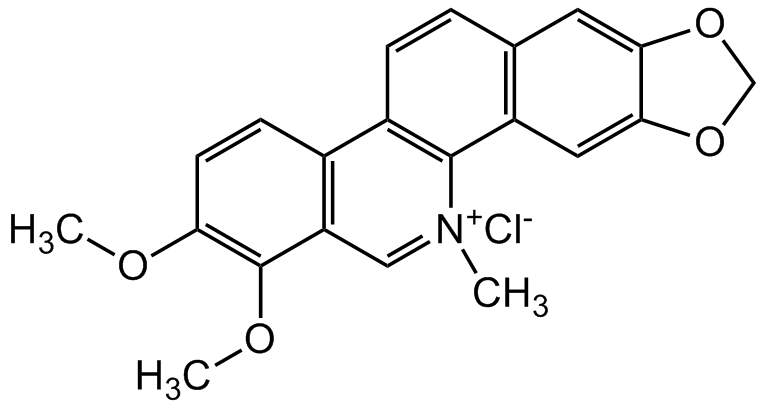Chelerythrine chloride
| Code | Size | Price |
|---|
| AG-CR1-0071-M001 | 1 mg | £35.00 |
Quantity:
| AG-CR1-0071-M005 | 5 mg | £65.00 |
Quantity:
| AG-CR1-0071-M025 | 25 mg | £230.00 |
Quantity:
Prices exclude any Taxes / VAT
Overview
Regulatory Status: RUO
Shipping:
-20°C
Storage:
-20°C
Images
Documents
Further Information
Alternate Names/Synonyms:
NSC 36405; 1,2-Dimethoxy-N-methyl-[1,3]benzodioxolo[5,6-c]phenanthridinium chloride
Appearance:
Yellow to dark yellow solid.
CAS:
3895-92-9
EClass:
32160000
Form (Short):
liquid
GHS Symbol:
GHS07
Handling Advice:
Protect from light when in solution.
Hazards:
H302, H312, H315, H319, H332, H335
InChi:
InChI=1S/C21H18NO4.ClH/c1-22-10-16-13(6-7-17(23-2)21(16)24-3)14-5-4-12-8-18-19(26-11-25-18)9-15(12)20(14)22;/h4-10H,11H2,1-3H3;1H/q+1;/p-1
InChiKey:
WEEFNMFMNMASJY-UHFFFAOYSA-M
Long Description:
Chemical. CAS: 3895-92-9. Formula: C21H18ClNO4. MW: 383.8. Cell permeable potent inhibitor of protein kinase C. Does not inhibit tyrosine protein kinases, cAMP-dependent protein kinase or calcium/calmodulin-dependent protein kinase. Antiplatelet, anti-inflammatory, antibacterial and antitumor compound. Apoptosis inducer in cancer cells in vitro and in vivo. Activates MAPK and JUNK signaling pathways. Affects translocation of PKC from cytosol to plasma membrane. Neurite outgrowth stimulator. Inhibits binding of BclXL to Bak (IC50 = 1.5 µM) or Bad proteins and stimulates apoptosis in several cancer cell lines. Blocks human P2X7 receptor. Induces cell cycle arrest in G1 phase. Specific cyclooxygenase-2 inhibitor.
MDL:
MFCD00060717
Molecular Formula:
C21H18ClNO4
Molecular Weight:
383.8
Package Type:
Vial
Precautions:
P261, P271, P280, P301, P312, P304, P340, P302, P352
Product Description:
Cell permeable potent inhibitor of protein kinase C. Does not inhibit tyrosine protein kinases, cAMP-dependent protein kinase or calcium/calmodulin-dependent protein kinase [1, 5]. Antiplatelet, anti-inflammatory, antibacterial and antitumor compound [1, 2, 9, 12, 15]. Apoptosis inducer in cancer cells in vitro and in vivo [3, 9]. Activates MAPK and JUNK signaling pathways [4, 8]. Affects translocation of PKC from cytosol to plasma membrane [6]. Neurite outgrowth stimulator [7]. Inhibits binding of BclXL to Bak (IC50 = 1.5 µM) or Bad proteins and stimulates apoptosis in several cancer cell lines [10, 13]. Blocks human P2X7 receptor [11]. Induces cell cycle arrest in G1 phase [14]. Specific cyclooxygenase-2 inhibitor [15].
Purity:
>98% (NMR)
Signal word:
Warning
SMILES:
[Cl-].COC1=C(OC)C2=C(C=C1)C1=C(C3=C(C=C1)C=C1OCOC1=C3)[N+](C)=C2
Solubility Chemicals:
Soluble in DMSO, ethanol, methanol or water (2mg/ml warm).
Transportation:
Non-hazardous
UNSPSC Category:
Biochemical Reagents
UNSPSC Number:
12352200
Use & Stability:
Stable for at least 2 years after receipt when stored at -20°C.
References
Chelerythrine is a potent and specific inhibitor of protein kinase C: J.M. Herbert, et al.; BBRC 172, 993 (1990) | Antiplatelet effects of chelerythrine chloride isolated from Zanthoxylum simulans: F.N. Ko, et al.; Biochim. Biophys. Acta 1052, 360 (1990) | Induction of apoptotic DNA fragmentation and cell death in HL-60 human promyelocytic leukemia cells by pharmacological inhibitors of protein kinase C: W.D. Jarvis, et al.; Cancer Res. 54, 1707 (1994) | Role of c-jun in human myeloid leukemia cell apoptosis induced by pharmacological inhibitors of protein kinase C: A.J. Freemerman, et al.; Mol. Pharmacol. 49, 788 (1996) | Angoline and chelerythrine, benzophenanthridine alkaloids that do not inhibit protein kinase C: S.K. Lee, et al.; J. Biol. Chem. 273, 19829 (1998) | Inhibition of protein kinase C translocation from cytosol to membrane by chelerythrine: M.D. Chao, et al.; Planta Med. 64, 662 (1998) | Axonal transport is inhibited by a protein kinase C inhibitor in cultured isolated mouse dorsal root ganglion cells: H. Hiruma, et al.; Brain. Res. 826, 135 (1999) | Activation of p38 and c-Jun N-terminal kinase pathways and induction of apoptosis by chelerythrine do not require inhibition of protein kinase C: R. Yu, et al.; J. Biol. Chem. 275, 9612 (2000) | In vitro and in vivo activity of protein kinase C inhibitor chelerythrine chloride induces tumor cell toxicity and growth delay in vivo: S.J. Chmura, et al.; Clin. Cancer Res. 6, 737 (2000) | Identification of chelerythrine as an inhibitor of BclXL function: S.L. Chan, et al.; J. Biol. Chem. 278, 20453 (2003) | Chelerythrine and other benzophenanthridine alkaloids block the human P2X7 receptor: A.N. Shemon, et al.; Br. J. Pharmacol. 142, 1015 (2004) | The effect of chelerythrine on cell growth, apoptosis, and cell cycle in human normal and cancer cells in comparison with sanguinarine: J. Malikova, et al.; Cell Biol. Toxicol. 22, 439 (2006) | Chelerythrine induces apoptosis through a Bax/Bak-independent mitochondrial mechanism: K.F. Wan, et al.; J. Biol. Chem. 283, 8423 (2008) | Chelerythrine and dihydrochelerythrine induce G1 phase arrest and bimodal cell death in human leukemia HL-60 cells: J. Vrba, et al.; Toxicol. In Vitro. 22, 1008 (2008) | Effects of chelerythrine, a specific inhibitor of cyclooxygenase-2, on acute inflammation in mice: X.F. Niu, et al.; Fitoterapia 82, 620 (2011)



